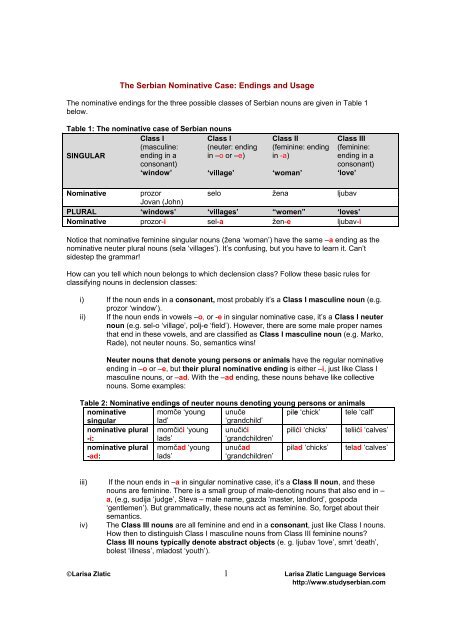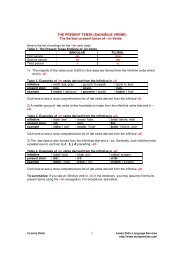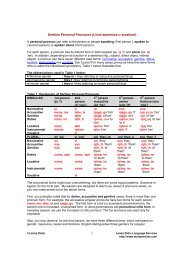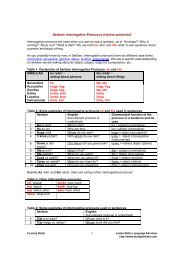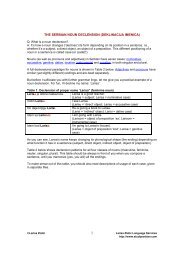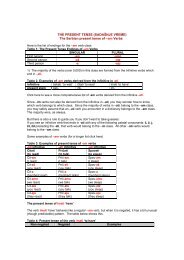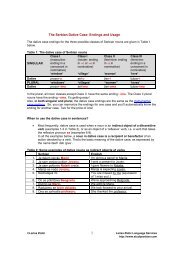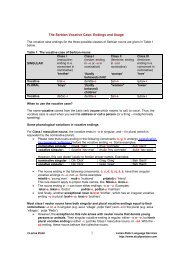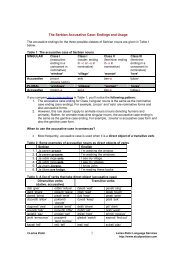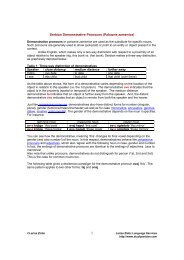The Serbian Nominative Case: Endings and Usage - Larisa Zlatic's ...
The Serbian Nominative Case: Endings and Usage - Larisa Zlatic's ...
The Serbian Nominative Case: Endings and Usage - Larisa Zlatic's ...
You also want an ePaper? Increase the reach of your titles
YUMPU automatically turns print PDFs into web optimized ePapers that Google loves.
<strong>The</strong> <strong>Serbian</strong> <strong>Nominative</strong> <strong>Case</strong>: <strong>Endings</strong> <strong>and</strong> <strong>Usage</strong><br />
<strong>The</strong> nominative endings for the three possible classes of <strong>Serbian</strong> nouns are given in Table 1<br />
below.<br />
Table 1: <strong>The</strong> nominative case of <strong>Serbian</strong> nouns<br />
SINGULAR<br />
Class I<br />
(masculine:<br />
ending in a<br />
consonant)<br />
‘window’<br />
Class I<br />
(neuter: ending<br />
in –o or –e)<br />
‘village’<br />
Class II<br />
(feminine: ending<br />
in -a)<br />
‘woman’<br />
Class III<br />
(feminine:<br />
ending in a<br />
consonant)<br />
‘love’<br />
<strong>Nominative</strong> prozor selo žena ljubav<br />
Jovan (John)<br />
PLURAL ‘windows’ ‘villages’ “women” ‘loves’<br />
<strong>Nominative</strong> prozor-i sel-a žen-e ljubav-i<br />
Notice that nominative feminine singular nouns (žena ‘woman’) have the same –a ending as the<br />
nominative neuter plural nouns (sela ‘villages’). It’s confusing, but you have to learn it. Can’t<br />
sidestep the grammar!<br />
How can you tell which noun belongs to which declension class? Follow these basic rules for<br />
classifying nouns in declension classes:<br />
i) If the noun ends in a consonant, most probably it’s a Class I masculine noun (e.g.<br />
prozor ‘window’).<br />
ii) If the noun ends in vowels –o, or -e in singular nominative case, it’s a Class I neuter<br />
noun (e.g. sel-o ‘village’, polj-e ‘field’). However, there are some male proper names<br />
that end in these vowels, <strong>and</strong> are classified as Class I masculine noun (e.g. Marko,<br />
Rade), not neuter nouns. So, semantics wins!<br />
Neuter nouns that denote young persons or animals have the regular nominative<br />
ending in –o or –e, but their plural nominative ending is either –i, just like Class I<br />
masculine nouns, or –ad. With the –ad ending, these nouns behave like collective<br />
nouns. Some examples:<br />
Table 2: <strong>Nominative</strong> endings of neuter nouns denoting young persons or animals<br />
nominative momče ‘young unuče<br />
pile ‘chick’ tele ‘calf’<br />
singular<br />
lad’<br />
‘gr<strong>and</strong>child’<br />
nominative plural momčići ‘young unučići<br />
pilići ‘chicks’ teliići ‘calves’<br />
-i:<br />
lads’<br />
‘gr<strong>and</strong>children’<br />
nominative plural momčad ‘young unučad pilad ‘chicks’ telad ‘calves’<br />
-ad:<br />
lads’<br />
‘gr<strong>and</strong>children’<br />
iii) If the noun ends in –a in singular nominative case, it’s a Class II noun, <strong>and</strong> these<br />
nouns are feminine. <strong>The</strong>re is a small group of male-denoting nouns that also end in –<br />
a, (e.g, sudija ‘judge’, Steva – male name, gazda ‘master, l<strong>and</strong>lord’, gospoda<br />
‘gentlemen’). But grammatically, these nouns act as feminine. So, forget about their<br />
semantics.<br />
iv) <strong>The</strong> Class III nouns are all feminine <strong>and</strong> end in a consonant, just like Class I nouns.<br />
How then to distinguish Class I masculine nouns from Class III feminine nouns?<br />
Class III nouns typically denote abstract objects (e. g. ljubav ‘love’, smrt ‘death’,<br />
bolest ‘illness’, mladost ‘youth’).<br />
©<strong>Larisa</strong> Zlatic 1 <strong>Larisa</strong> Zlatic Language Services<br />
http://www.studyserbian.com
This class of nouns is not productive, i.e. when a new noun that ends in a consonant<br />
is imported into the language, it goes into Class I (masculine nouns), not into Class<br />
III (feminine nouns). For example, the loan noun stres (from the English ‘stress’) is<br />
classified as a Class I masculine noun.<br />
When to use the nominative case in sentences?<br />
• <strong>The</strong> nominative case is typically used as the subject of a sentence. As a<br />
consequence, the nominative case can never appear after the preposition, unlike other<br />
cases.<br />
Notice that in the examples below, subjects can occur anywhere in the sentence, not only<br />
in the initial position. Word order is pretty free. At least, something easy!<br />
Table 3: Some examples of nominative nouns as subjects<br />
<strong>Serbian</strong> English<br />
1. Prozor je čist. <strong>The</strong> window is clean.<br />
2. Jovan je došao iz Beograda. John came from Belgrade.<br />
3. Ova žena dugo spava. This woman sleeps a lot.<br />
4. Ja vidim moje selo. I see my village.<br />
5. Čist je prozor. (Clean is the window. = same as 1.)<br />
6. Došao je iz Beograda Jovan. (came from Belgrade John = same<br />
meaning as in 2.)<br />
<strong>Nominative</strong> case is also used in copular or predicative sentences (sentences that use verb biti ‘to<br />
be’ as the main verb). Some examples:<br />
Table 4: Some examples of nominative nouns in predicative sentences<br />
<strong>Serbian</strong> English<br />
Milan je lekar. Milan is a doctor.<br />
Milan je bio dobar lekar. Milan was a good doctor.<br />
Ovo je Beograd. This is Belgrade.<br />
One su glumice. <strong>The</strong>y are actresses.<br />
Ja sam <strong>Larisa</strong>. I am <strong>Larisa</strong>.<br />
Ja se zovem <strong>Larisa</strong>. I’m called <strong>Larisa</strong> (my name is <strong>Larisa</strong>)<br />
Notice that in the above sentences, which are also called ‘identificational’ constructions, both<br />
the subject (the noun before the conjugated verb biti ‘to be’) <strong>and</strong> the post-copular noun (shown in<br />
red) have nominative case.<br />
Unlike other cases that can occur as both objects of verbs <strong>and</strong> prepositions, nominative case<br />
cannot occur as the object of a preposition. (Note: the locative case is the only case that occurs<br />
only with prepositions.)<br />
To ask questions about the nominative case (subject), such as ‘Who/What is that?’ we use the<br />
following interrogative pronouns in the nominative case:<br />
Ko ‘who’ Šta ‘what’<br />
Table 5: Some examples of questions that ask about the subject<br />
<strong>Serbian</strong> English<br />
Question: Ko je došao?<br />
Who came?<br />
Answer: Jovan je došao.<br />
John came.<br />
Question: Ko je to? Who is that?<br />
©<strong>Larisa</strong> Zlatic 2 <strong>Larisa</strong> Zlatic Language Services<br />
http://www.studyserbian.com
Answer: To je profesor. That is a professor.<br />
Quesiton: Šta je ovo?<br />
What is this?<br />
Answer: Ovo je prozor.<br />
This is a window.<br />
Quesiton: Kako se zove ovo? How do you call this?<br />
Answer: Ovo se zove knjiga. This is called a book.<br />
Quesiton: Kako se kaže ‘book’? How do you say ‘book’?<br />
Answer: Book se kaže ‘knjiga’. Book is called ‘knjiga’.<br />
<strong>The</strong> last two questions can be very useful to find out how names of the objects or persons are<br />
called in <strong>Serbian</strong>. So, don’t be shy <strong>and</strong> keep asking your teacher or a native speaker for the<br />
names of the objects, so you can enrich your vocabulary, <strong>and</strong> also learn the nominative case.<br />
©<strong>Larisa</strong> Zlatic 3 <strong>Larisa</strong> Zlatic Language Services<br />
http://www.studyserbian.com
And now some exercises! If you get stuck or are not sure you got it right, please email me for<br />
help.<br />
Exercise 1 – Put the nouns below in the appropriate declension class<br />
Using the nouns below insert them in the appropriate cell of Table 5. An example is provided in<br />
the first row of the table.<br />
Miodrag (proper name) kafa ‘coffee’ zemlja ‘earth, soil’<br />
Dragica (proper name) šećer ‘sugar’ mesec ‘moon’<br />
Novi Sad (name of the city in Serbia) jare ‘kid –young goat’ zvezda ‘star’<br />
Dalas ‘Dallas’ koza ‘goat’ ogledalo ‘mirror’<br />
Florida voz ‘train’ čaša ‘glass’<br />
Italija ‘Italy’ autobus ‘bus’ pasulj ‘beans’<br />
Florida bol ‘pain’ veče ‘evening’<br />
vreme ‘time, weather’ tuga ‘sadness’ zora ‘dawn’<br />
život ‘life’ žalost ‘sorrow žito ‘wheat’<br />
korito ‘trough’ bure ‘barrel’ pivo ‘beer’<br />
vozač ‘driver’ zgrada ‘building’ zima ‘winter’<br />
Table 6: Classify the above nouns in the appropriate declension classes<br />
Class I<br />
(masculine nouns)<br />
Class I<br />
(neuter nouns)<br />
Class II (feminine<br />
nouns <strong>and</strong> some<br />
masculine nouns)<br />
nož pero trava radost<br />
Class III<br />
(feminine nouns)<br />
Exercise 2 – Translate the following sentences<br />
For this exercise you need to know both the present tense <strong>and</strong> past tense. <strong>The</strong> boldface nouns<br />
require the nominative case. If you don’t have a bi-directional <strong>Serbian</strong>-English-<strong>Serbian</strong><br />
dictionary, you may go to the website: http://www.krstarica.com/dictionary/ to get the words you<br />
need for this exercise. Note that for nouns, a dictionary will give you the nominative case forms.<br />
1. This is a vase.<br />
2. Branko is a teacher.<br />
3. This is called a pear.<br />
4. This is called an apple.<br />
5. That was my brother.<br />
6. What is that?<br />
7. <strong>The</strong>y are accountants.<br />
8. What is Zorica?<br />
9. She is a nurse.<br />
©<strong>Larisa</strong> Zlatic 4 <strong>Larisa</strong> Zlatic Language Services<br />
http://www.studyserbian.com


